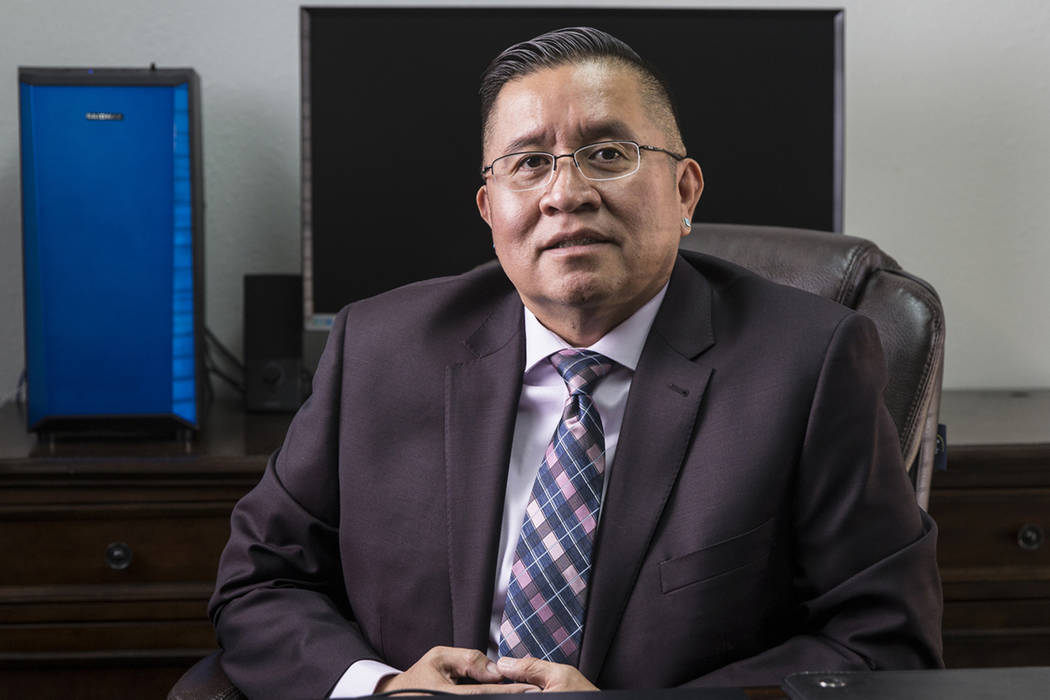Native Americans move to Las Vegas, but struggle to be recognized
Rulon Pete has been noticing a lot of new faces around town.
Over the past few years, the executive director of the Las Vegas Indian Center has seen an uptick in demand for his nonprofit’s employment programs for Native Americans.
Unemployment rates on tribal lands are higher than the U.S. average, and Pete said many of the 150 to 200 people he assists each year have moved here seeking employment in construction, health care and hospitality.
“Vegas presents itself as a place you can be able to have a good paying job and where people can sustain a decent lifestyle,” said Pete, who is a member of the Cedar Band of Paiutes in Utah. “They stay around and find out there are better opportunities here, and they spread the news back home.”
The U.S. Census Bureau estimates that between July 2017 and 2018 the number of Native Americans living in Clark County grew at a faster rate than any other large county in the nation. In fact, among counties with populations of 20,000 or more, Clark County had the fastest annual growth rate of Native Americans in three of the past five years.
Experts say more Native Americans are moving here because of Clark County’s strong economy, employment opportunities and proximity to reservations in Arizona, Utah and Southern California.
Today about 50,000 people who self-identify as Native American live in Clark County, according to census statistics. Close to half are multiracial and most live in urban areas. Census officials report less than 1,000 live on reservations for the county’s two federally recognized tribes, the Las Vegas Paiute Tribe and the Moapa Band of Paiutes.
Despite the population growth, Native Americans still represent only about 2 percent of the county’s population. Pete and others say they feel like they are still fighting to be recognized by the community at large.
That was the feeling in September, when the Clark County Commission punted voting on a resolution to designate the second Monday of October as Indigenous Peoples’ Day. Commissioners disagreed whether to hold the new celebration on the same day as Columbus Day, a reasoning some Native Americans see as a continuation of their historic marginalization.
Similar measures have been adopted by state and local governments across the nation, some of which have opted to stop celebrating Italian explorer Christopher Columbus’s first voyage to the Americas. In Clark County, the idea was to give at least equal recognition to the Native Americans who predated and then suffered violence from European colonization.
“The (Columbus Day) celebration was the discovery of America, but there were millions of people who were here,” said Las Vegas resident Mercedes Krause, a member of the Oglala Lakota Nation of South Dakota who serves on Nevada’s Commission on Minority Affairs. “I think it’s a step toward recognition. We are here. We’re part of our community.”
County Commissioner Tick Segerblom said he plans to improve the proposal and try again next year.
“We’ll bring it back and make sure all the commissioners are fully briefed ahead of time and understand the importance,” he said.
Growing recognition
Native Americans have not gone totally without recognition in Nevada.
In 2016 the Moapa Band of Paiutes saw nearly 300,000 acres of their ancestral land northeast of Las Vegas designated as the Gold Butte National Monument.
Less than a year later former Gov. Brian Sandoval proclaimed Aug. 9 as Indigenous Peoples’ Day in Nevada.
And last month, the Nevada State Democratic Party established a statewide Native American caucus with a seat on the party’s executive board. The recognition dovetails nicely with an ongoing nonpartisan effort to increase the state’s Native American voter turnout.
One organizer behind the state’s get-out-the-vote effort said he hopes the recent efforts to improve civic engagement will bolster Native American participation in the 2020 census count.
“I was really excited to actually see the (recent Native American population estimates) catch up with what we’ve always known about the region,” said Patrick Naranjo, a member of New Mexico’s Santa Clara Pueblo. “Historically, Native individuals have been underrepresented within the framework of this entire structure.”
During the last decennial census, Native Americans living on reservations were undercounted by about 5 percent nationwide. That was more than double the rate of the next closest population group, said James Tucker, a Las Vegas-based attorney who serves as vice-chair to the Census Bureau’s National Advisory Committee.
The difficulty of performing an accurate headcount on tribal lands is not solely rooted in their geographic isolation. Tucker said it is also caused by language barriers, nontraditional mailing addresses and a historic distrust of the federal government.
Even a move to make participation easier, encouraging people to complete the census survey online, could falter in Indian country. The Census Bureau reports more than a quarter of tribal-area households nationwide don’t have internet access, but Tucker said even tribal households with access often have slow and unreliable service or rely on cellphones to use the internet.
And for every person left uncounted, tribes in Nevada will lose federal funding. That’s money used to maintain critical infrastructure like roads, schools and health-care facilities, Tucker said.
“You’re talking about very under-resourced and underserved areas of the country,” he said. “There are a lot of barriers out there. It is a very difficult task, but it’s not an impossible task. It’s going to require everyone coming together.”
The Las Vegas Paiute Tribe declined to comment for this story. Officials with the Moapa Band of Paiutes did not return multiple interview requests.
Challenges ahead
Native Americans continue to face challenges across a number of social issues in Southern Nevada and across the U.S.
Compared with the overall population, Native Americans are more likely to live in poverty and less likely to have graduated high school or college, according to census statistics. Activists across the country are trying to shine light on what they describe as an epidemic of missing and murdered Native American women, both in tribal and urban areas.
“All the things you hear nationally are here in our small community also,” Krause said.
In Southern Nevada, there is no Indian Health Services hospital. The Moapa Band of Paiutes are protesting the U.S. Air Force’s push to expand the the Nevada Test and Training Range further into the Desert National Wildlife Refuge.
Krause believes representation in government is key to having Native Americans’ concerns heard. Every decision maker should “have a Native voice at the table,” she said.
“We’re not at that tipping point yet, or even close, but I’m very proud of the recognition we’re getting,” she said. “We have to keep speaking up.”
Contact Michael Scott Davidson at sdavidson@reviewjournal.com or 702-477-3861. Follow @davidsonlvrj on Twitter.



















